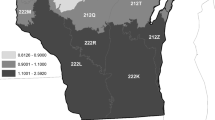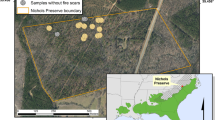Abstract
Longleaf pine (Pinus palustris) historically was a widespread ecosystem composed of a simple tree canopy and grasslands ground layer. After widespread loss of this ecosystem due to logging and fire exclusion, little quantitative information exists about historical structure for restoration goals. We identified composition in De Soto National Forest and Pearl River County, Mississippi, USA, and density, basal area, and percent stocking in Pearl River County using General Land Office surveys and US Forest Service Forest Inventory and Analysis surveys. Historical longleaf ecosystems were about 85% pine, with lesser amounts of broadleaf evergreen and oak species. Densities were about 175 to 180 trees/ha, mean tree diameters were 45 cm, and stocking was around 60% to 65%, which suggested longleaf pines were closed woodlands. Current forests are 38% to 57% pine, primarily loblolly, while longleaf pine is 2% to 8% of composition. Indeed, current longleaf pine composition across the Coastal Plain averages 3% and does not reach 10% at smaller landscape scales. Fire-sensitive broadleaf species of water oak, sweetgum, yellow-poplar, and red maple increased from about 0.5% composition to 2% to 10% of composition. Forests became twice as dense, at about 280 trees/ha to 330 trees/ha, with mean tree diameters of 22 cm. These results characterize conversion from open old growth longleaf forests, resulting in part from human maintenance, to successional forests due to human disruption of the historical ecosystem. It is important to remember structure and composition of historical forests for restoration and recognize wholesale changes so that successional forests do not become the new social and cultural baseline.


Similar content being viewed by others
References
Arner, S. L., Woudenberg, S., Waters, S., Vissage, J., MacLean, C., Thompson, M., and Hansen, M. (2001). National Algorithms for Determining Stocking Class, Stand Size Class, and Forest Type for Forest Inventory and Analysis Plots, US Department of Agriculture, Forest Service, Northeastern Research, Newtown Square, PA.
Bechtold, W. A., and Patterson, P. L. (2005). The enhanced forest inventory and analysis program-national sampling design and estimation procedures. Gen. Tech. Rep. SRS-80. U.S. Department of Agriculture, Forest Service, Southern Research Station, Asheville, NC.
Black, B. A., Foster, H. T., and Abrams, M. D. (2002). Combining Environmentally Dependent and Independent Analyses of Witness Tree Data in East-Central Alabama. Canadian Journal of Forest Research 32: 2060–2075.
Cleland, D., Freeouf, J., Keys, J., Nowacki, G., Carpenter, C., and McNab, W. (2007). Ecological Subregions: Sections and Subsections for the Conterminous United States, U.S. Department of Agriculture, Forest Service, Washington, DC.
Conner, R. C., and Hartsell, A. J. (2002). Forest area and conditions. In Wear, D.N., and Greis, J.G. (eds.), Southern Forest Resource Assessment. Gen. Tech. Rep. SRS-53. U.S. Department of Agriculture, Forest Service, southern Research Station, Asheville, NC, pp. 357–402.
Elsner, J. B., Jagger, T. H., and Liu, K.-b. (2008). Comparison of Hurricane Return Levels Using Historical and Geological Records. Journal of Applied Meteorology and Climatology 47: 368–374.
Fowler, C., and Konopik, E. (2007). The History of Fire in the Southern United States. Human Ecology Review 14: 165–176.
Frost, C. C. (1993). Four centuries of changing landscape patterns in the longleaf pine ecosystem. In Hermann, S. M. (ed.), Proceedings of the Tall Timbers Fire Ecology Conference, Vol. 18. Tall Timbers Research Station, Tallahassee, FL, pp. 17–43.
Hanberry, B. B., Fraver, S., He, H. S., Yang, J., Dey, D. C., and Palik, B. J. (2011). Spatial Pattern Corrections and Sample Sizes for Forest Density Estimates of Historical Tree Surveys. Landscape Ecology 26: 59–68.
Hanberry, B. B., Hanberry, P., Riffell, S. K., Demarais, S., and Jones, J. C. (2012a). Bird Assemblages of Intensively Established Pine Plantations in Coastal Plain Mississippi. Journal of Wildlife Management 76: 1205–1214.
Hanberry, B. B., Yang, J., Kabrick, J. M., and He, H. S. (2012b). Adjusting Forest Density Estimates for Surveyor Bias in Historical Tree Surveys. American Midland Naturalist 167: 285–306.
Hanberry, B. B., Jones-Farrand, D. T., and Kabrick, J. M. (2014a). Historical Open Forest Ecosystems in the Missouri Ozarks: Reconstruction and Restoration Targets. Ecological Restoration 32: 407–416.
Hanberry, B. B., Kabrick, J. M., and He, H. S. (2014b). Densification and State Transition Across the Missouri Ozarks Landscape. Ecosystems 17: 66–81.
Haynes, R. W. (2002). Forest Management in the 21st Century: Changing Numbers, Changing Context. Journal of Forestry 100: 38–43.
Lorimer, C. G. (2001). Historical and Ecological Roles of Disturbance in Eastern North American Forests: 9,000 years of Change. Wildlife Society Bulletin 29: 425–439.
Mattoon, W. R. (1915). Life History of Shortleaf Pine, US Dept. of Agriculture, Washington DC.
Means, D. B. (1996). Longleaf pine forest, going, going. In Davis, M. B. (ed.), Eastern Old-Growth Forests: Prospects for Rediscovery and Recovery, Island Press, Washington, DC, pp. 210–229.
Means, D. B. (2006). Vertebrate faunal diversity of longleaf pine ecosystems. In Jose, S., Jokela, E. J., and Miller, D. L. (eds.), The Longleaf Pine Ecosystem: Ecology, Silviculture, and Restoration, Springer, New York, NY, pp. 157–213.
Mohr, C. T., and Roth, F. (1897). The Timber Pines of the Southern United States, US Government Printing Office, Washington DC.
Noss, R. F., LaRoe, E. T., III, Scott, J. M. (1995). Endangered ecosystems of the United States: A preliminary assessment of loss and degradation. U.S. Department of the Interior, National Biological Service, Washington, DC.
Peet, R. K., and Allard, D. J. (1993). Longleaf pine vegetation of the southern Atlantic and eastern Gulf Coast regions. In Hermann, S. M. (ed.), Proceedings of the Tall Timbers Fire Ecology Conference, Vol. 18. Tall Timbers Research Station, Tallahassee, FL, pp. 45–81.
Plummer, G. L. (1975). 18th Century Forests in Georgia. Bulletin of the Georgian Academy of Sciences 33: 1–19.
Predmore, S. A., McDaniel, J., and Kush, J. S. (2007). Presettlement Forests and Fire in Southern Alabama. Canadian Journal of Forest Research 37: 1723–1736.
Prestemon, J. P., and Abt, R. C. (2002). Forest area and conditions. In Wear, D. N., and Greis, J. G. (eds.), Southern Forest Resource Assessment. Gen. Tech. Rep. SRS-53, U.S. Department of Agriculture, Forest Service, Southern Research Station, Asheville, NC, pp. 299–324.
Regional Working Group for America’s Longleaf (2009). Range-wide conservation plan for longleaf pine. http://www.americaslongleaf.org/media/86/conservation_plan.pdf.
Schultz, R. P. (1997). Loblolly Pine: The Ecology and Culture of Loblolly Pine (Pinus taeda L.). Agriculture Handbook 713. US Department of Agriculture, Forest Service, Washington DC.
Schwartz, M. W. (1994). Natural Distribution and Abundance of Forest Species and Communities in Northern Florida. Ecology 75: 687–705.
Stambaugh, M. C., Guyette, R. P., and Marschall, J. (2011). Longleaf Pine (Pinus palustris Mill.) Fire Scars Reveal New Details of a Frequent Fire Regime. Journal of Vegetation Science 22: 1094–1104.
Steen, D. A., Conner, L., Smith, L. L., Provencher, L., Hiers, J. K., Pokswinski, S., Helms, B. S., and Guyer, C. (2013). Bird Assemblage Response to Restoration of Fire-Suppressed Longleaf Pine Sandhills. Ecological Applications 23: 134–147.
Van Lear, D. H., Carroll, W., Kapeluck, P., and Johnson, R. (2005). History and Restoration of the Longleaf Pine-Grassland Ecosystem: Implications for Species at Risk. Forest Ecology and Management 211: 150–165.
Wahlenberg, W. G. (1946). Longleaf Pine: Its Use, Ecology, Regeneration, Protection, Growth, and Management, C.L. Pack Forestry Foundation and USDA Forest Service, Washington, DC.
Walker, J. (1993). Rare vascular plant taxa associated with the longleaf pine ecosystems: Patterns in taxonomy and ecology. In Hermann, S. M. (ed.), Proceedings of the Tall Timbers Fire Ecology Conference, Vol. 18. Tall Timbers Research Station, Tallahassee, FL, pp. 105–126.
Ware, S., Frost, C., and Doerr, P. D. (1993). Southern mixed hardwood forest: the former longleaf pine forest. In Martin, W. H., Boyce, S. G., and Echternacht, A. C. (eds.), Biodiversity of the Southeastern United States: Lowland Terrestrial Communities, Wiley, New York, NY, pp. 447–493.
White, C. R., and Harley, G. L. (2016). Historical Fire in Longleaf Pine (Pinus palustris) Forests of South Mississippi and its Relation to Land Use and Climate. Ecosphere 7: e01458.
Acknowledgements
Views in this paper do not necessarily reflect those of the USDA Forest Service.
Author information
Authors and Affiliations
Corresponding author
Ethics declarations
Conflict of Interest
The authors declare that they have no conflicts of interest.
The authors approved the manuscript and are responsible for interpretation of results and for any errors contained in this paper.
Rights and permissions
About this article
Cite this article
Hanberry, B.B., Coursey, K. & Kush, J.S. Structure and Composition of Historical Longleaf Pine Ecosystems in Mississippi, USA. Hum Ecol 46, 241–248 (2018). https://doi.org/10.1007/s10745-018-9982-1
Published:
Issue Date:
DOI: https://doi.org/10.1007/s10745-018-9982-1




